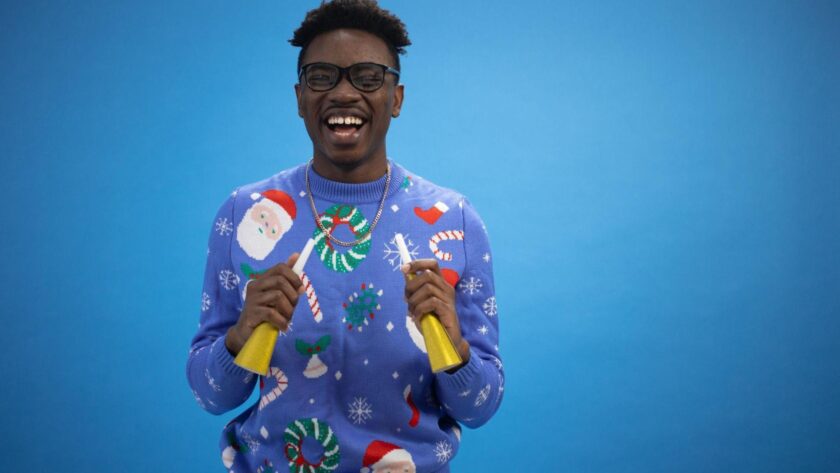Any sweater with a Christmas motif that some could find offensive, garish, or ostentatious is fair game for the label ugly Christmas sweater. The more decorations a Christmas sweater has, such as tinsel, Rudolph, Santa Clauses, lollipops, elves, gifts, etc., the more people tend to dislike it.
Where did the ugly sweater really get its jumpstart? At one point, somebody loved them and thought the masses at large would love them also. The fashion world teeters back and forth on the opinion of the ugly sweater, so if yours isn’t in style this year, it probably will be next year.
A throwback to the ’80s
It seems every comedian in the 80’s was part of the sweater club. Most of them were cardigans, which button up the front of the garment. The advent of mass-produced Christmas sweaters in the 1980s coincided with the introduction of this motif, which had been popular in Europe from the early 19th century. Click here to read more about jingle bells. ;

An Emerging Custom
Despite the fact that nobody wants to take credit for starting the trend, ugly Christmas sweaters have become a global phenomenon. The first-ever “ugly sweater” Christmas party was held in 2002 in Vancouver, and the host has staked a claim to the title of Naruto sweater spiritual home.
This party is a fundraiser for Make A Wish Canada, an organization that grants the last wishes of very sick children. The guests all try to outdo one another in holiday hideous sweaters, and it helps sick kids at Christmas. What better way to get some use out of that knit nightmare?
Inquiring minds want to know: what makes a sweater “ugly” for Christmas?
There are no hard and fast requirements, but they are often wooly pullovers, although cardigans surely count, have so many hues in one sweater that labeling it as sparkly glitter-toned doesn’t do it credit, and likely constructed of many materials that are generally synthetic and can either be or not be comfy.
A Christmas tree, Santa Claus, a snowman, candy canes, or reindeer may all be present, among other seasonal symbols. And you get additional points for theme mashups related to Christmas, interactive features, such as an ugly Christmas sweater that serves as a drinking game, or 3D components, such as jingle bells or Santa’s fuzzy beard.
These monstrosities first appeared in the 1950s, when winter and Christmas-themed apparel, such as sweaters, entered mass production. This was likely in response to the increasing commercialization of Christmas after World War II. Several people even regarded the holiday sweaters to be works of art, but they didn’t sell very well. Nonetheless, many of the most famous TV stars of the day wore them. Once they were spotted on the sitcom of the times, they would sell out in the store.
Despite this, the popularity of Christmas sweaters did not skyrocket until the 1980s, when they began to appear in television and cinema on some of our all-time favorite characters. It wasn’t long before ugly Christmas sweaters became a party staple, allowing coworkers to poke fun at themselves at what can be a trying time of year for many. Ugly Christmas sweaters saw a brief renaissance in the early 1990s before slowly losing steam throughout the decade. At the start of 2000, it was a major fashion faux pas to be seen in one.
Knitwear and Sweater Origins and Development
We’ve been wearing sweaters, or knitted tops, for a lot longer than the famed ugly Christmas sweater. Knitted garments are made by knitting needles looping or knitting yarn to make a fabric. Sadly, non-Christmas-sweater knitted clothes’ history is difficult to trace as knitting does not need a loom. Instead, historians have relied on the few pieces of knitwear that have survived.
Egyptian Coptic sock remnants and complete socks from about the year 1000 CE are the oldest known instances of the “two-needle” style of knitting used today. They were woven from cotton colored white and blue and included Kufic patterns, which are symbolic designs.
Go ahead in time to the 17th century, and you’ll notice a new trend in knitwear. James Thomas Brudenell, 7th Earl of Cardigan and top general, is commemorated with the naming of the cardigan (https://www.britannica.com/dictionary/cardigany) sweater. Brudenell is most known for leading his men into Death Valley during The Charging of the Light Brigade. Knitted military jackets, sometimes known as “cardigans,” were issued to Brudenell’s men.
It’s surprising that the ancient Egyptians’ inventions and the British military’s uniforms resulted in such an ostentatious celebration of the holiday season. However, it’s become a fun tradition that is celebrated in many countries, and not just for Christmas. The trend has been seen during Hanukkah and other festive holidays around the world and only seems to be picking up speed.
Don’t be embarrassed. Grab yourself a Naruto sweater and join in the holiday hilarity.



